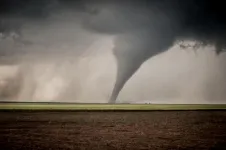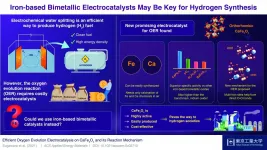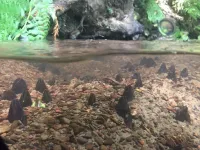(Press-News.org) The United States experiences more tornadoes than any other country, with a season that peaks in spring or summer depending on the region. Tornadoes are often deadly, especially in places where buildings can't withstand high winds.
Accurate advanced warnings can save lives. A study from the University of Washington and the National Oceanic and Atmospheric Administration describes a new way to rate and possibly improve tornado warnings. It finds that nighttime twisters, summer tornadoes and smaller events remain the biggest challenges for the forecasting community.
"This new method lets us measure how forecast skill is improving, decreasing or staying the same in different situations," said Alex Anderson-Frey, a UW assistant professor of atmospheric sciences. "The tornado forecasting community needs to know what we're doing best at, and where we can focus training and research in the future."
She is lead author of the paper published online in December in the Bulletin of the American Meteorological Society.
Though the southern and central U.S. see the most tornadoes, every state can experience twisters. Scientific understanding of tornadoes is biased toward populated places, Anderson-Frey said, where people are more likely to observe and report the events.
"As population density increases in different areas, including outside the U.S., I think we're getting more of an idea of the range of environments in which tornadoes can actually form," Anderson-Frey said.
The paper develops a new method to rate the skill of a tornado warning based on the difficulty of the environment. It then evaluates thousands of tornadoes and associated warnings over the continental United States between 2003 and 2017.
The NOAA-funded study finds that nighttime tornadoes have a lower probability of detection and a higher false-alarm rate than the environmental conditions would suggest. Summertime tornadoes, occurring in June, July or August, also are more likely to evade warning.
The nighttime events may be harder to forecast because the absence of daytime warming makes the conditions less favorable, and because there were fewer eyewitness reports, Anderson-Frey said. Summer events may be more difficult because summer has more relatively weak tornadoes that occur in marginal environments, meaning on the edge of conditions that produce a tornado.
Larger events -- those rated 2 or above on the enhanced Fujita scale -- actually generated better warnings than expected for the conditions. The results can inform how research, training or observational technology could improve future tornado warnings.
"The forecasting community is not just looking at the big, photogenic situations that will crop up in the Great Plains. We're looking at tornadoes in regions where vulnerability is high, including in regions that don't normally get tornadoes, where by definition the vulnerability is high," Anderson-Frey said.
"There's a real effort in the forecasting research community to bring in the human element -- being able to identify where we can do the most good."
Although tornado forecasts and warnings are improving overall, so are some types of risk. Populations are growing and moving into new, remote environments. Mobile or manufactured homes without anchored foundations are less able to withstand high winds.
"What really excites me about this work is the opportunity to look at performance by how difficult the warning situation was," said co-author Harold Brooks at NOAA's National Severe Storm Laboratory in Norman, Oklahoma. "We have the chance to measure improvement through the years taking into account that some situations and years may be harder or easier forecasts."
Anderson-Frey She moved from Oklahoma to join the UW faculty in 2019. In related research, she is now analyzing data for past tornadoes to determine the environmental conditions that can produce events in unexpected places, like the 2018 tornado that struck Port Orchard in Washington state.
"I'm working on applying a machine-learning technique to studying what prototypical tornadic environments look like in different parts of the United States," she said.
INFORMATION:
For more information, contact Anderson-Frey at akaf@uw.edu.
A recent study of how human resources professionals review online information and social media profiles of job candidates highlights the ways in which so-called "cybervetting" can introduce bias and moral judgment into the hiring process.
"The study drives home that cybervetting is ultimately assessing each job candidate's moral character," says Steve McDonald, corresponding author of the study and a professor of sociology at North Carolina State University. "It is equally clear that many of the things hiring professionals are looking at make it more likely for ...
p>
Boulder, Colo., USA: Several new articles were published online ahead of
print for Geology in February. Topics include stress in survivor
plants following the collapse of land ecosystems, the Gulf of Aden, whether
the Denali fault is still active, the first reported Burgess Shale-type
fauna rediscovered, and redefining the age of the lower Colorado River.
These Geology articles are online at END ...
Researchers from Skoltech's Intelligent Space Robotics Lab have proposed a novel method for customer behavior analytics and demand distribution based on Radio Frequency Identification (RFID) stocktaking. Their research was published in the proceedings of the International Conference on Control, Automation, Robotics and Vision (ICARCV).
Autonomous robotic systems that already pervade our daily lives are faced with a host of challenging tasks, such as stocktaking in a rapidly changing environment.
A Skoltech team led by Professor Dzmitry Tsetserukou from the Skoltech Space Center (Intelligent Space Robotics Lab) has proposed a novel method that helps ...
EUGENE, Ore. - March 2, 2021 - High-resolution imaging and 3D computer modeling show that the dendrites of neurons weave through space in a way that balances their need to connect to other neurons with the costs of doing so.
The discovery, reported in Nature Scientific Reports Jan. 27, emerged as researchers sought to understand the fractal nature of neurons as part of a University of Oregon project to design fractal-shaped electrodes to connect with retinal neurons to address vision loss due to retinal diseases.
"The challenge in our research has been understanding how the neurons we want to target in the retina will connect to our electrodes," said Richard Taylor, a professor and head ...
An analysis of law enforcement seizures of illegal drugs in five key regions of the United States revealed a rise in methamphetamine and marijuana (cannabis) confiscations during the COVID-19 pandemic. Seizures of the two drugs were higher at their peak in August 2020 than at any time in the year prior to the pandemic. While investigators found that trends in heroin, cocaine and fentanyl seizures were not affected by the pandemic, provisional overdose death data show that the increased drug mortality seen in 2019 rose further through the first half of 2020.
The findings suggest that the pandemic and its related restrictions may ...
Washington, DC-- March 2, 2021 -- Detecting COVID-19 outbreaks before they spread could help contain the virus and curb new cases within a community. This week in mSystems, an open-access Journal of the American Society for Microbiology, researchers from the University of California San Diego describe a mostly-automated early alert system that uses high-throughput analysis of wastewater samples to identify buildings where new COVID-19 cases have emerged--even before infected people develop symptoms.
The approach is fast, cost-effective, and sensitive enough to detect a single ...
Today, we can say without a shadow of doubt that an alternative to fossil fuels is needed. Fossil fuels are not only non-renewable sources of energy but also among the leading causes of global warming and air pollution. Thus, many scientists worldwide have their hopes placed on what they regard as the fuel of tomorrow: hydrogen (H2). Although H2 is a clean fuel with incredibly high energy density, efficiently generating large amounts of it remains a difficult technical challenge.
Water splitting--the breaking of water molecules--is among the most explored methods to produce H2. While there are many ways ...
Pesticides used in forestry may threaten species in downstream rivers and estuaries, but little is known about the extent to which this occurs. A new study by researchers at Portland State University found mussels, clams and oysters in watersheds along the Oregon Coast are exposed to pesticides used in managing forests. The results of this study, published in the journal Toxics, have implications for developing better forest management practices that are less likely to negatively affect aquatic life.
The study was led by Kaegan Scully-Engelmeyer, PhD student in the Earth, Environment and Society program at Portland ...
The coronavirus pandemic has drawn new attention to the digital divide, as the need for online schooling and working from home has disproportionately hurt those without computer equipment and skills.
Research by Paul A. Pavlou, dean of the C. T. Bauer College of Business at the University of Houston, found that people with basic Information Technology (IT) skills - including the ability to use email, copy and paste files and work with an Excel spreadsheet - are more likely to be employed, even in jobs that aren't explicitly tied to those skills.
People with more advanced IT skills generally earned higher salaries, the researchers found. The work is described in Information Systems Research.
"Unemployment and low wages remain pressing societal challenges in the wake of increased ...
A new study has shown that gentle streams of water carrying sound and microscopic air bubbles can clean bacteria from salad leaves more effectively than current washing methods used by suppliers and consumers. As well as reducing food poisoning, the findings could reduce food waste and have implications for the growing threat of anti-microbial resistance.
Salad and leafy green vegetables may be contaminated with harmful bacteria during growing, harvesting, preparation and retail leading to outbreaks of food poisoning which may be fatal in vulnerable groups.
Because there is no cooking process to ...





